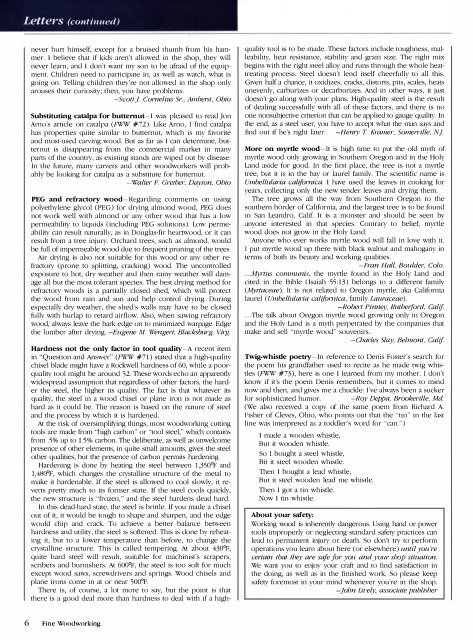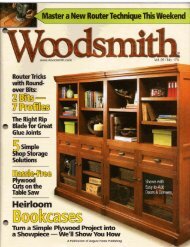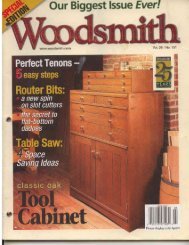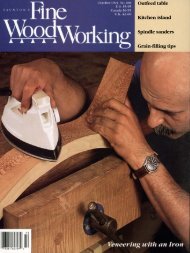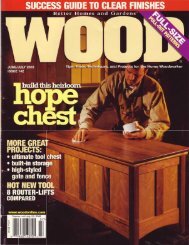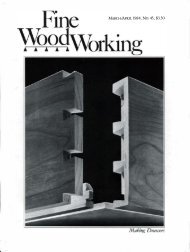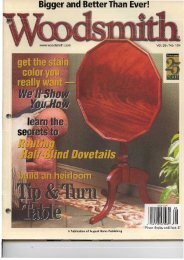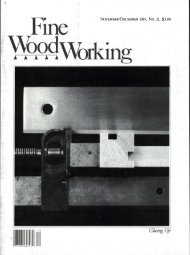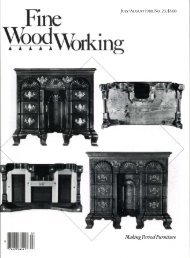Untitled - MetosExpo - Free
Untitled - MetosExpo - Free
Untitled - MetosExpo - Free
Create successful ePaper yourself
Turn your PDF publications into a flip-book with our unique Google optimized e-Paper software.
Letters (contillued)never hurt himself, except for a bruised thumb from his hammer.I believe that if kids aren't allowed in the shop, they willnever learn, and 1 don't want my son to be afraid of the equipment.Children need to participate in, as well as watch, what isgoing on. Telling children they're not allowed in the shop onlyarouses their curiosity; then, you have problems.-Scott j. Cornelius Sr., Amberst, ObioSubstituting catalpa for butternut- I was pleased to read JonArno's article on catalpa (FWW' #72). Like Arno, 1 find catalpahas properties quite similar to butternut, which is my favoriteand most-used carving wood. But as far as I can determine, buttermltis disappearing from the commercial market in manyparts of the country, as existing stands are wiped out by disease.In the future, many carvers and other woodworkers will probablybe looking for catalpa as a substitute for butternut.-Wa lter F Gretber, Dayton, ObioPEG and refractory wood-Regarding comments on usingpolyethylene glycol (PEG) for drying almond wood, PEG doesnot work well with almond or any other wood that has a lowpermeability to liquids (including PEG solutions). Low permeabilitycan result naturally, as in Douglas-fir heartwood, or it canresult from a tree injury. Orchard trees, such as almond, wouldbe full of impermeable wood due to frequent pruning of the trees.Air drying is also not suitable for this wood or any other refractory(prone to splitting, cracking) wood. The uncontrolledexposure to hot, dry weather and then rainy weather will damageall but the most tolerant species. The best drying method forrefractory woods is a partially closed shed, which will protectthe wood from rain and sun and help control drying. Duringespecially dry weather, the shed's walls may have to be closedfully with burlap to retard airflow. Also, when sawing refractorywood, always leave the bark edge on to minimized warpage. Edgethe lumber after drying. -Eugene M. Wengert, Blacksburg, VirgHardness not the only factor in tool quality-A recent itemin "Question and Answer" (FWW' #71) stated that a high-qualitychisel blade might have a Rockwell hardness of 60, while a poorqualitytool might be around 52. These words echo an apparentlywidespread assumption that regardless of other factors, the harderthe steel, the higher its quality. The fact is that whatever itsquality, the steel in a wood chisel or plane iron is not made ashard as it could be. The reason is based on the nature of steeland the process by which it is hardened.At the risk of oversimplifying things, most woodworking cuttingtools are made from "high carbon" or "tool steel," which containsfrom 5% up to l.5% carbon. The deliberate, as well as unwelcomepresence of other elements, in quite small amounts, gives the steelother qualities, but the presence of carbon permits hardening.Hardening is done by heating the steel between 1,350or- and1,480or-, which changes tlle crystalline structure of the metal tomake it hardenable. If the steel is allowed to cool slowly, it revertspretty much to its former state. If the steel cools quickly,the new structure is "frozen," and the steel hardens dead hard.In this dead-hard state, the steel is brittle. If you made a chiselout of it, it would be tough to shape and sharpen, and the edgewould chip and crack. To achieve a better balance betweenhardness and utility, the steel is softened. This is done by reheatingit, but to a lower temperature than before, to change thecrystalline structure. This is called tempering. At about 430"F,quite hard steel will result, suitable for machinist's scrapers,scribers and burnishers. At 600or-, the steel is too soft for muchexcept wood saws, screwdrivers and springs. Wood chisels andplane irons come in at or near 500or-.There is, of course, a lot more to say, but the point is thatthere is a good deal more than hardness to deal witll if a high-quality tool is to be made. These factors include toughness, malleability,heat resistance, stability and grain size. The right mixbegins with tile right steel alloy and runs through the whole heattreatingprocess. Steel doesn't lend itself cheerfully to all this.Given half a chance, it oxidizes, cracks, distorts, pits, scales, heatsunevenly, carburizes or decarburizes. And in other ways, it justdoesn't go along with your plans. High-quality steel is the resultof dealing successfully with all of these factors, and there is noone nonsubjective criterion that can be applied to gauge quality. Intile end, as a steel user, you have to accept what tile man says andfind out if he's right later. -Henry T. Kramer, Somerville, Nj.More on myrtle wood-It is high time to put the old myth ofmyrtle wood only growing in Southern Oregon and in the HolyLand aside for good. In the first place, the tree is not a myrtletree, but it is in the bay or laurel family. The scientific name isUmbellularia cali/arnica. 1 have used tlle leaves in cooking foryears, collecting only the new tender leaves and drying them.The tree grows all the way from Southern Oregon to thesouthern border of California, and tile largest tree is to be foundin San Leandro, Calif. It is a monster and should be seen byanyone interested in that species. Contrary to belief, myrtlewood does not grow in the Holy Land.Anyone who ever works myrtle wood will fall in love with it.I put myrtle wood up there with black walnut and mahogany interms of bOtil its beauty and working qualities.-Fran Hall, Boulder, Colo ... . Myrtus communis, tlle myrtle found in the Holy Land andcited in the Bible (Isaiah 55:13) belongs to a different family(Myrtaceae). It is not related to Oregon myrtle, aka Californialaurel (Umbellularia cali/arnica, family Lauraceae).-Robert Pinney, Rutbeliord, Calif.... The talk about Oregon myrtle wood growing only in Oregonand the Holy Land is a myth perpetrated by the companies thatmake and sell "myrtle wood" souvenirs.-Cbarles Slay, Belmont, Calif.Twig-whistle poetry-In reference to Denis Foster's search forthe poem his grandfather used to recite as he made twig whistles(FWW #73), here is one I learned from my mother. I don'tknow if it's the poem Denis remembers, but it comes to mindnow and tllen, and gives me a chuckle: I've always been a suckerfor sophisticated humor. -Roy Deppa, Brookeville, Md.(We also received a copy of the same poem from Richard A.Fisher of Cleves, Ohio, who points out that tlle "tin" in the lastline was interpreted a a toddler'S word for "can.")I made a wooden whistle,But it wooden whistle.So 1 bought a steel whistle,Bit it steel wooden whistle.Then 1 bought a lead whistle,But it steel wooden lead me whistle.Then I got a tin whistle.Now I tin whistle.About your safety:Working wood is inherently dangerous. Using hand or powertools improperly or neglecting standard safety practices canlead to permanent injury or death. So don't try to performoperations you learn about here (or elsewhere) until you'recertain tbat tbey are safe for you and your sbop situation.We want you to enjoy your craft and to find satisfaction inthe doing, as well as in the finished work. So please keepsafety foremost in your mind whenever you're in the shop.-Jobn Lively, associate publisber6 Fine Woodworking


